Jianheng Tang
SegACIL: Solving the Stability-Plasticity Dilemma in Class-Incremental Semantic Segmentation
Dec 14, 2024Abstract:While deep learning has made remarkable progress in recent years, models continue to struggle with catastrophic forgetting when processing continuously incoming data. This issue is particularly critical in continual learning, where the balance between retaining prior knowledge and adapting to new information-known as the stability-plasticity dilemma-remains a significant challenge. In this paper, we propose SegACIL, a novel continual learning method for semantic segmentation based on a linear closed-form solution. Unlike traditional methods that require multiple epochs for training, SegACIL only requires a single epoch, significantly reducing computational costs. Furthermore, we provide a theoretical analysis demonstrating that SegACIL achieves performance on par with joint learning, effectively retaining knowledge from previous data which makes it to keep both stability and plasticity at the same time. Extensive experiments on the Pascal VOC2012 dataset show that SegACIL achieves superior performance in the sequential, disjoint, and overlap settings, offering a robust solution to the challenges of class-incremental semantic segmentation. Code is available at https://github.com/qwrawq/SegACIL.
UniGAD: Unifying Multi-level Graph Anomaly Detection
Nov 10, 2024Abstract:Graph Anomaly Detection (GAD) aims to identify uncommon, deviated, or suspicious objects within graph-structured data. Existing methods generally focus on a single graph object type (node, edge, graph, etc.) and often overlook the inherent connections among different object types of graph anomalies. For instance, a money laundering transaction might involve an abnormal account and the broader community it interacts with. To address this, we present UniGAD, the first unified framework for detecting anomalies at node, edge, and graph levels jointly. Specifically, we develop the Maximum Rayleigh Quotient Subgraph Sampler (MRQSampler) that unifies multi-level formats by transferring objects at each level into graph-level tasks on subgraphs. We theoretically prove that MRQSampler maximizes the accumulated spectral energy of subgraphs (i.e., the Rayleigh quotient) to preserve the most significant anomaly information. To further unify multi-level training, we introduce a novel GraphStitch Network to integrate information across different levels, adjust the amount of sharing required at each level, and harmonize conflicting training goals. Comprehensive experiments show that UniGAD outperforms both existing GAD methods specialized for a single task and graph prompt-based approaches for multiple tasks, while also providing robust zero-shot task transferability. All codes can be found at https://github.com/lllyyq1121/UniGAD.
GCoder: Improving Large Language Model for Generalized Graph Problem Solving
Oct 24, 2024
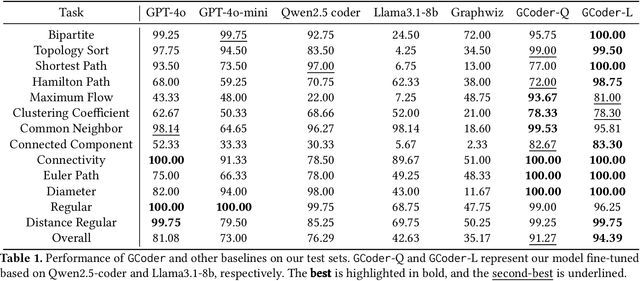


Abstract:Large Language Models (LLMs) have demonstrated strong reasoning abilities, making them suitable for complex tasks such as graph computation. Traditional reasoning steps paradigm for graph problems is hindered by unverifiable steps, limited long-term reasoning, and poor generalization to graph variations. To overcome these limitations, we introduce GCoder, a code-based LLM designed to enhance problem-solving in generalized graph computation problems. Our method involves constructing an extensive training dataset, GraphWild, featuring diverse graph formats and algorithms. We employ a multi-stage training process, including Supervised Fine-Tuning (SFT) and Reinforcement Learning from Compiler Feedback (RLCF), to refine model capabilities. For unseen tasks, a hybrid retrieval technique is used to augment performance. Experiments demonstrate that GCoder outperforms GPT-4o, with an average accuracy improvement of 16.42% across various graph computational problems. Furthermore, GCoder efficiently manages large-scale graphs with millions of nodes and diverse input formats, overcoming the limitations of previous models focused on the reasoning steps paradigm. This advancement paves the way for more intuitive and effective graph problem-solving using LLMs. Code and data are available at here: https://github.com/Bklight999/WWW25-GCoder/tree/master.
Graph Pre-Training Models Are Strong Anomaly Detectors
Oct 24, 2024
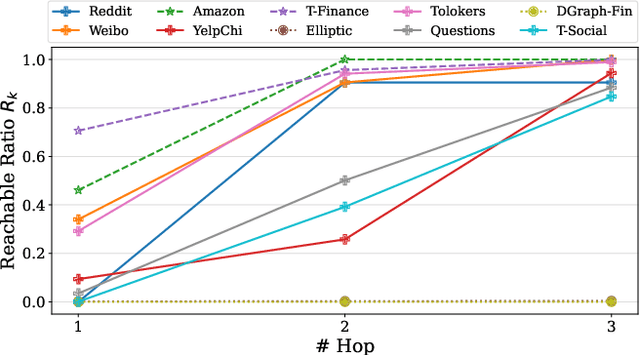

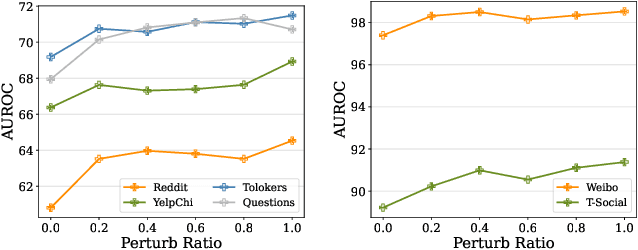
Abstract:Graph Anomaly Detection (GAD) is a challenging and practical research topic where Graph Neural Networks (GNNs) have recently shown promising results. The effectiveness of existing GNNs in GAD has been mainly attributed to the simultaneous learning of node representations and the classifier in an end-to-end manner. Meanwhile, graph pre-training, the two-stage learning paradigm such as DGI and GraphMAE, has shown potential in leveraging unlabeled graph data to enhance downstream tasks, yet its impact on GAD remains under-explored. In this work, we show that graph pre-training models are strong graph anomaly detectors. Specifically, we demonstrate that pre-training is highly competitive, markedly outperforming the state-of-the-art end-to-end training models when faced with limited supervision. To understand this phenomenon, we further uncover pre-training enhances the detection of distant, under-represented, unlabeled anomalies that go beyond 2-hop neighborhoods of known anomalies, shedding light on its superior performance against end-to-end models. Moreover, we extend our examination to the potential of pre-training in graph-level anomaly detection. We envision this work to stimulate a re-evaluation of pre-training's role in GAD and offer valuable insights for future research.
TS-ACL: A Time Series Analytic Continual Learning Framework for Privacy-Preserving and Class-Incremental Pattern Recognition
Oct 21, 2024Abstract:Class-incremental Learning (CIL) in Time Series Classification (TSC) aims to incrementally train models using the streaming time series data that arrives continuously. The main problem in this scenario is catastrophic forgetting, i.e., training models with new samples inevitably leads to the forgetting of previously learned knowledge. Among existing methods, the replay-based methods achieve satisfactory performance but compromise privacy, while exemplar-free methods protect privacy but suffer from low accuracy. However, more critically, owing to their reliance on gradient-based update techniques, these existing methods fundamentally cannot solve the catastrophic forgetting problem. In TSC scenarios with continuously arriving data and temporally shifting distributions, these methods become even less practical. In this paper, we propose a Time Series Analytic Continual Learning framework, called TS-ACL. Inspired by analytical learning, TS-ACL transforms neural network updates into gradient-free linear regression problems, thereby fundamentally mitigating catastrophic forgetting. Specifically, employing a pre-trained and frozen feature extraction encoder, TS-ACL only needs to update its analytic classifier recursively in a lightweight manner that is highly suitable for real-time applications and large-scale data processing. Additionally, we theoretically demonstrate that the model obtained recursively through the TS-ACL is exactly equivalent to a model trained on the complete dataset in a centralized manner, thereby establishing the property of absolute knowledge memory. Extensive experiments validate the superior performance of our TS-ACL.
GraphArena: Benchmarking Large Language Models on Graph Computational Problems
Jun 29, 2024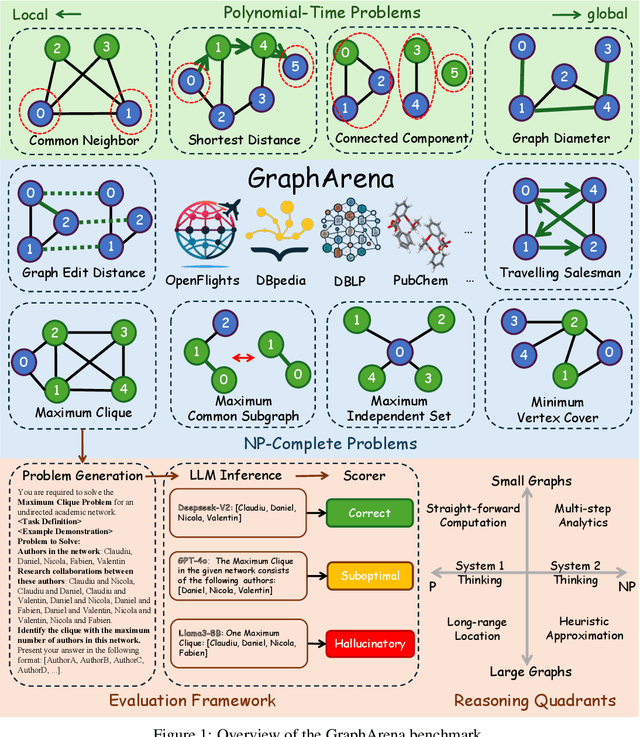
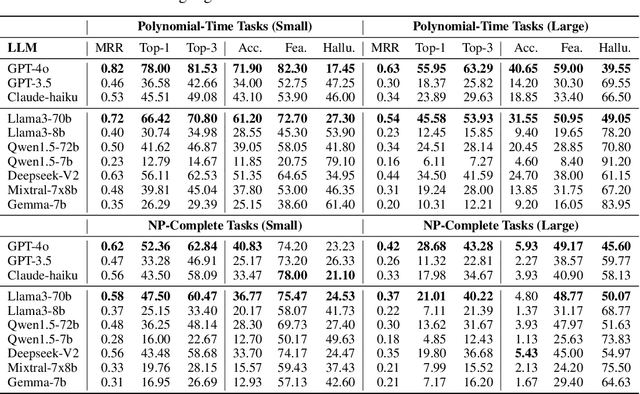
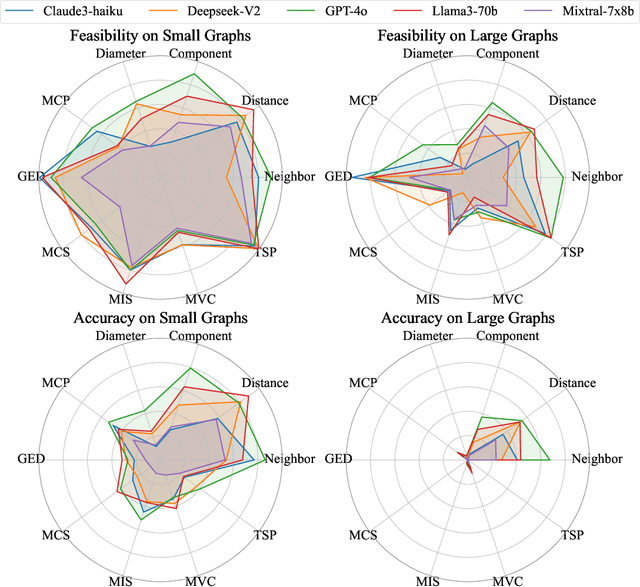
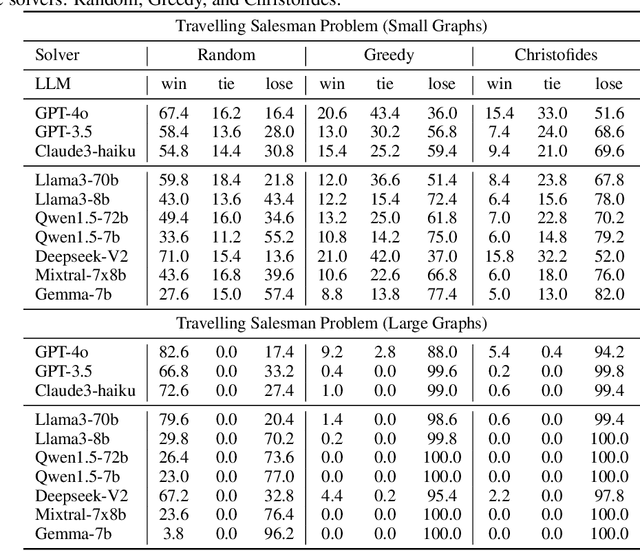
Abstract:The "arms race" of Large Language Models (LLMs) demands novel, challenging, and diverse benchmarks to faithfully examine their progresses. We introduce GraphArena, a benchmarking tool designed to evaluate LLMs on graph computational problems using million-scale real-world graphs from diverse scenarios such as knowledge graphs, social networks, and molecular structures. GraphArena offers a suite of 10 computational tasks, encompassing four polynomial-time (e.g., Shortest Distance) and six NP-complete challenges (e.g., Travelling Salesman Problem). It features a rigorous evaluation framework that classifies LLM outputs as correct, suboptimal (feasible but not optimal), or hallucinatory (properly formatted but infeasible). Evaluation of 10 leading LLMs, including GPT-4o and LLaMA3-70B-Instruct, reveals that even top-performing models struggle with larger, more complex graph problems and exhibit hallucination issues. Despite the application of strategies such as chain-of-thought prompting, these issues remain unresolved. GraphArena contributes a valuable supplement to the existing LLM benchmarks and is open-sourced at https://github.com/squareRoot3/GraphArena.
4DBInfer: A 4D Benchmarking Toolbox for Graph-Centric Predictive Modeling on Relational DBs
Apr 28, 2024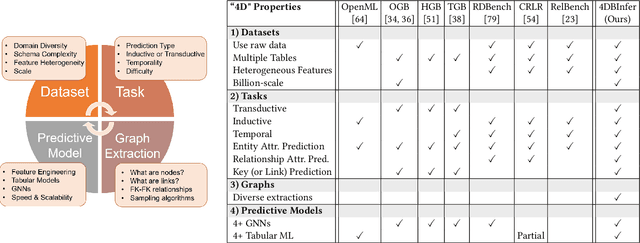
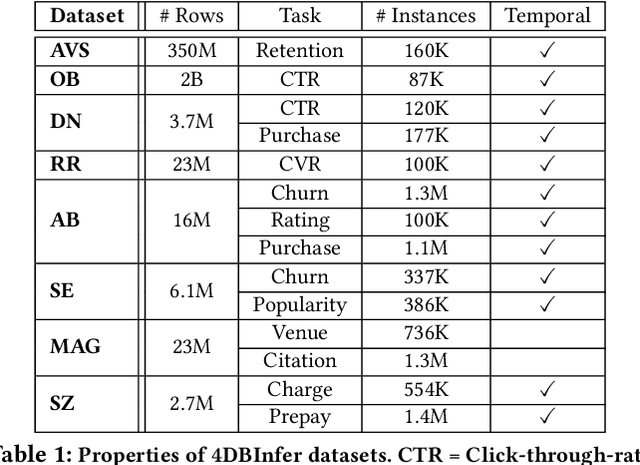

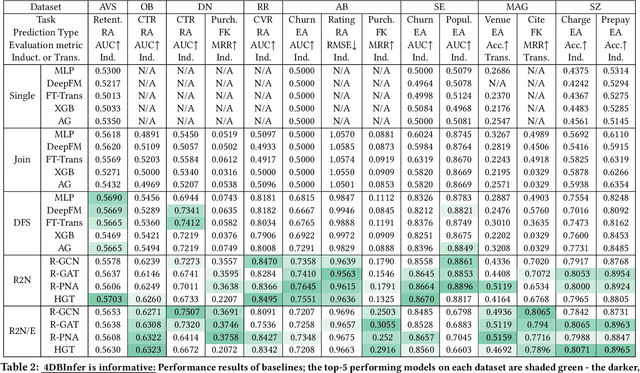
Abstract:Although RDBs store vast amounts of rich, informative data spread across interconnected tables, the progress of predictive machine learning models as applied to such tasks arguably falls well behind advances in other domains such as computer vision or natural language processing. This deficit stems, at least in part, from the lack of established/public RDB benchmarks as needed for training and evaluation purposes. As a result, related model development thus far often defaults to tabular approaches trained on ubiquitous single-table benchmarks, or on the relational side, graph-based alternatives such as GNNs applied to a completely different set of graph datasets devoid of tabular characteristics. To more precisely target RDBs lying at the nexus of these two complementary regimes, we explore a broad class of baseline models predicated on: (i) converting multi-table datasets into graphs using various strategies equipped with efficient subsampling, while preserving tabular characteristics; and (ii) trainable models with well-matched inductive biases that output predictions based on these input subgraphs. Then, to address the dearth of suitable public benchmarks and reduce siloed comparisons, we assemble a diverse collection of (i) large-scale RDB datasets and (ii) coincident predictive tasks. From a delivery standpoint, we operationalize the above four dimensions (4D) of exploration within a unified, scalable open-source toolbox called 4DBInfer. We conclude by presenting evaluations using 4DBInfer, the results of which highlight the importance of considering each such dimension in the design of RDB predictive models, as well as the limitations of more naive approaches such as simply joining adjacent tables. Our source code is released at https://github.com/awslabs/multi-table-benchmark .
GraphWiz: An Instruction-Following Language Model for Graph Problems
Mar 06, 2024



Abstract:Large language models (LLMs) have achieved impressive success across several fields, but their proficiency in understanding and resolving complex graph problems is less explored. To bridge this gap, we introduce GraphInstruct, a novel and comprehensive instruction-tuning dataset designed to equip language models with the ability to tackle a broad spectrum of graph problems using explicit reasoning paths. Utilizing GraphInstruct, we build GraphWiz, an open-source language model capable of resolving various graph problem types while generating clear reasoning processes. To enhance the model's capability and reliability, we incorporate the Direct Preference Optimization (DPO) framework into the graph problem-solving context. The enhanced model, GraphWiz-DPO, achieves an average accuracy of 65% across nine tasks with different complexity levels, surpassing GPT-4 which has an average accuracy of 43.8%. Moreover, our research delves into the delicate balance between training data volume and model performance, highlighting the potential for overfitting with increased data. We also explore the transferability of the model's reasoning ability across different graph tasks, indicating the model's adaptability and practical application potential. Our investigation offers a new blueprint and valuable insights for developing LLMs specialized in graph reasoning and problem-solving.
GADBench: Revisiting and Benchmarking Supervised Graph Anomaly Detection
Jun 21, 2023



Abstract:With a long history of traditional Graph Anomaly Detection (GAD) algorithms and recently popular Graph Neural Networks (GNNs), it is still not clear (1) how they perform under a standard comprehensive setting, (2) whether GNNs outperform traditional algorithms such as tree ensembles, and (3) their efficiency on large-scale graphs. In response, we present GADBench -- a comprehensive benchmark for supervised anomalous node detection on static graphs. GADBench provides a thorough comparison across 23 distinct models on ten real-world GAD datasets ranging from thousands to millions of nodes ($\sim$6M). Our main finding is that tree ensembles with simple neighborhood aggregation outperform all other baselines, including the latest GNNs tailored for the GAD task. By making GADBench available as an open-source tool, we offer pivotal insights into the current advancements of GAD and establish a solid foundation for future research. Our code is available at https://github.com/squareRoot3/GADBench.
A Fused Gromov-Wasserstein Framework for Unsupervised Knowledge Graph Entity Alignment
May 11, 2023Abstract:Entity alignment is the task of identifying corresponding entities across different knowledge graphs (KGs). Although recent embedding-based entity alignment methods have shown significant advancements, they still struggle to fully utilize KG structural information. In this paper, we introduce FGWEA, an unsupervised entity alignment framework that leverages the Fused Gromov-Wasserstein (FGW) distance, allowing for a comprehensive comparison of entity semantics and KG structures within a joint optimization framework. To address the computational challenges associated with optimizing FGW, we devise a three-stage progressive optimization algorithm. It starts with a basic semantic embedding matching, proceeds to approximate cross-KG structural and relational similarity matching based on iterative updates of high-confidence entity links, and ultimately culminates in a global structural comparison between KGs. We perform extensive experiments on four entity alignment datasets covering 14 distinct KGs across five languages. Without any supervision or hyper-parameter tuning, FGWEA surpasses 21 competitive baselines, including cutting-edge supervised entity alignment methods. Our code is available at https://github.com/squareRoot3/FusedGW-Entity-Alignment.
 Add to Chrome
Add to Chrome Add to Firefox
Add to Firefox Add to Edge
Add to Edge